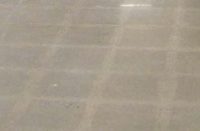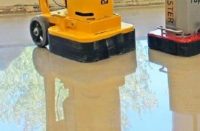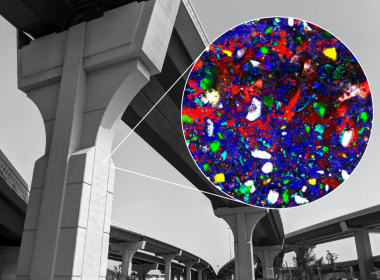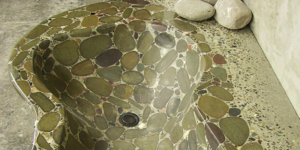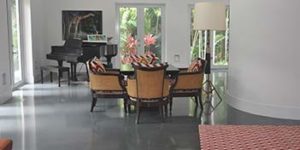Historically, chemistry for polished concrete consisted only of a hardener-densifier, and it was often viewed as an added expense with an unknown benefit. The times are changing.
Currently, we can identify nine unique categories of chemical accessories for polished concrete.
Pre-grind chemistry is used before we even run a diamond across the concrete.
Repair products fill surface voids so that we can achieve truer surface reflection and shine.
Densifier-hardener is considered a necessity.
Topical color came into vogue when acetone dyes were introduced.
Color enhancers help bring a floor more vividly to life.
Stain resistance product allow the use of polished concrete in environments where food is prepared, served and spilled.
Protection products are often applied at the end of every polish job.
Slurry management options have expanded with the popularity of wet grinding.
Maintenance and slip prevention products (including treatments and cleaners to improve coefficient of friction) are coming to the forefront.
Let’s consider some of the driving reasons for the existence of each category. When you are on a polishing job and a situation arises, these chemistries allow you to complete your job better, faster, and with greater profitability and customer satisfaction. Let’s also consider some pros and cons.
Pre-grind treatments help improve the appearance of concrete by removing the laitance, salts and haze that can occur as a result of wet curing. Proper use will remove the residue and expose the actual concrete. This becomes important when you’re polishing a cream finish and a uniform color is needed.
Pre-grind chemistry also helps with removal of the hard, burnt concrete cap created by overtroweling or previous densification. By keeping the product wet, etching the concrete with pre-grind treatments, and breaking the surface tension, you can start to expose an aggregate or sand finish.
These chemicals allow for a uniform first cut. More benefits are significantly less diamond usage, fewer passes, and less labor (up to 30 percent less time) during the first cut. The downsides are the use of acids, the need for neutralizers, and added product cost.
Repair products are used in concert with the grinder to fill in and hide surface imperfections. Repair chemistries currently include resinous chemistries (epoxy, polyurethane, polyurea), acrylic or latex, and silicate.
Resinous epoxies, u rethanes, polyurethanes and polyureas are coated onto the entire area in need of filling. Once cured, these resinous coatings are cut with metal diamonds, leaving an effective clear fill. The downsides are that they require significant downtime, may not be UV stable, and are not able to take color or densifier.
Straight acrylic/latex technologies are the most widely used repair systems due to ease of use, minimal cost, and lack of needed waiting time. Hybrid formulations contain silicates and resinous filler. The disadvantage of these types of products is that they cannot absorb color or densifier.
Catalyzed silicate technology is chemically compatible with both color and densifier and requires little or no waiting. The downsides are that the process may require more attention to detail and the cost per square foot may be higher depending upon the actual surface.
Topical color is leading polished concrete into the forefront of architectural design. The two categories of concrete surface color are reactive and nonreactive. Both will penetrate into concrete and polish up beautifully, yielding a gorgeous colored, polished concrete floor. With the correct carrier, topical colors leave no surface film. Reactive materials such as acid stain or silicate pigmented stain result in permanent color characteristics. Nonreactive dyes will penetrate and dwell where left, but they can be affected by environmental conditions such as moisture, UV exposure and pH.
Densifier comes in four primary chemical types: sodium, colloidal silica, potassium and lithium. The reactive metals are the carriers for the silicates, which do the actual densification. All will harden the surface, increasing abrasion resistance and allowing the polished shine to last longer. The key factors in each densifier are application rates and the percentage of active silicate. When properly applied to rejection, all four chemistries improve the finished result, and the cost differential is usually minimal. Select a system that is easy to apply, performs well and that offers you effective service and support.
Color enhancers help satisfy the demand for a more vivid appearance as our customers’ expectations grow. These products are not film-forming and are applied after polishing is complete. The downsides are another product cost and another labor step to consider.
Stain resistance products are applied after polishing to reduce the surface vulnerability to organic acid staining. The first technology is a low-cost, water-based fixative that removes unreacted silicates from concrete pores. Unreacted silicates can chemically respond to a liquid spill and result in a permanent stain. These fixatives require a water rinse.
The second technology is an impregnator — its oleophobic and hydrophobic properties hold off spilled liquids longer, allowing the spill to be removed before it can react. This technology has a steeper price associated with it and requires another step. The technologies can be used together on the same floor.
Protection products are applied once the polish is complete. These come in two general types, film-forming and nonfilm-forming. Both can hide scratches and blemishes and can increase stain resistance and shine. The film former is more common but tends to be vulnerable to moisture for the first 72 hours and requires reapplication as it wears off. The nonfilm-former requires burnishing and can be more labor-intensive. The advantage of a nonfilm-former is that since there is no film, no wear patterns can be created, and therefore, there is little need for reapplication.
Slurry management chemistry allows wet grinding to be a cleaner process. Gelling agents, polymers or other absorbent chemicals absorb the water and turn the grinding slurry into a semisolid waste for disposal. The process requires labor and equipment to evenly blend the chemicals into slurry, and it yields a greater mass.
This complements “separation,” in which flocculants and settling agent drop solids to the bottom of a container, allowing the water to be decanted and reused or, in accordance with regulations, pH-balanced before disposal. Once the water is siphoned off, the reduced solids are ready for appropriate disposal.
Both technologies can be used together — separate out the solids first, then pour off the water and gel the sediment for disposal.
Maintenance and slip prevention products follow job completion. Simple floor-cleaning products should be slightly alkaline (with a pH of 8-10), and must be rinsed off for the floor to maintain clarity of shine.
Slip prevention products can be either no-rinse or rinse-required. Slip prevention products increase the surface coefficient of friction — dynamic and static, wet and dry. However, they also may alter the shine and should be tested before use.
Separate articles could be written on each of these chemical technologies to fully explain their pros and cons and their usage with polished concrete. My intention is to pique your interest in the multitude of products available to assist with your installations, so that during a conversation or a production situation, you can confidently answer, “Yes, I can!”
